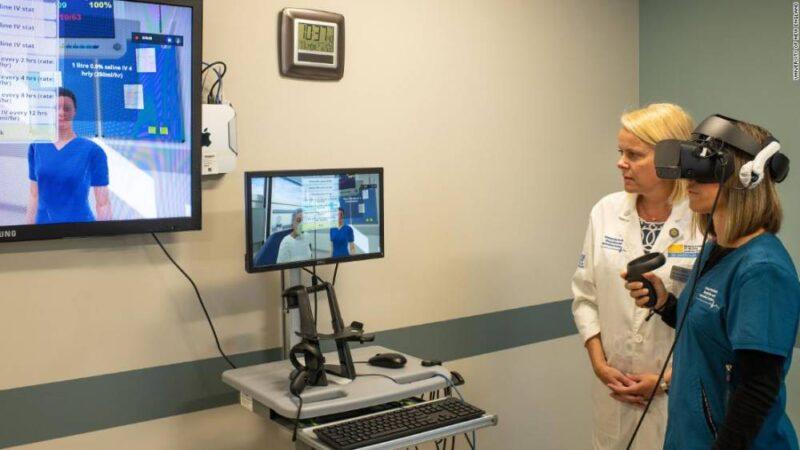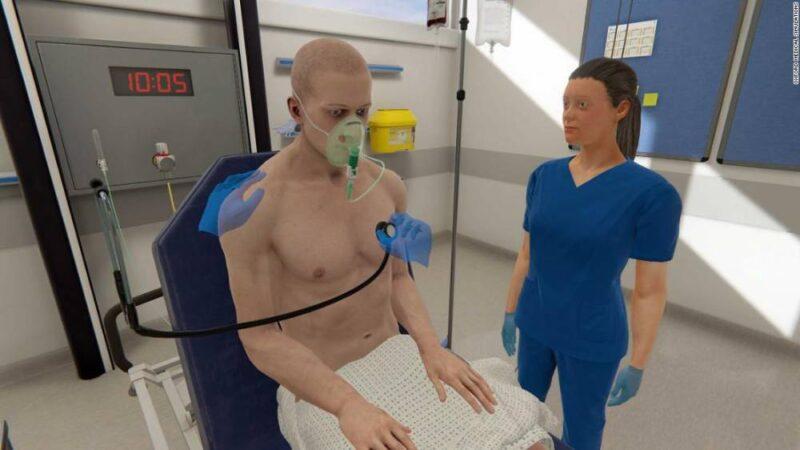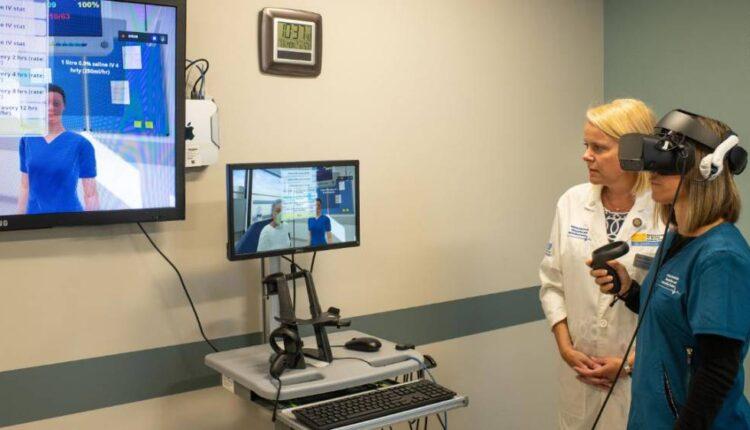New York (CNN Business)As hospitals worldwide face severe shortages of health professionals, people are being called off the sidelines to help COVID-19 patients — even those with little to no experience in treating infectious diseases.
To train thousands of doctors and nurses with expertise in other areas such as knee surgery or neurology — and retired practitioners reentering the medical field — some hospitals are implementing an unlikely method: virtual reality simulations.At Cedars-Sinai hospital in Los Angeles, more than 300 doctors have learned skills, such as how to assess a patient’s symptoms or perform CPR while wearing protective gear, through VR.
“It feels like you are in the room with a patient,” said Russell Metcalfe-Smith, the director of the Women’s Guild Simulation Center for Advanced Clinical Skills at Cedars-Sinai Medical Center, which has been rapidly training staff for COVID-19. “Based on the decisions you make in the simulation, one direction will lead to another. We have [doctors] jump quickly into a virtual environment like this to get them to where they need to be.” Doctors and nurses at hospitals nationwide are undergoing a variety coronavirus-specific trainings right now, including how to correctly put on and take off protective equipment, how to utilize ventilators that are typically only used by critical care staff, learning new guidelines around concepts such as basic CPR and life support, and managing a diagnosis.Read More

A nursing student at The University of New England undergoes a VR simulation to get ready for real-world hospital situationsBut because time and resources are limited, the door has opened for technologies like VR to fill in the gaps. Considering how the medical industry has long been an early adopter of VR, from using it as distraction therapy for medical procedures or even at the dentist, to a training method for surgeons, it’s a natural place for hospitals to turn.”We’ve found it very valuable to observe a [doctor’s thinking] process — and it’s all been done with social distancing,” Metcalfe-Smith said. “Because we can’t get large groups together right now, we’ve had to rely on technology like this to give the same experience — and we’re grateful for that.”The hospital uses software from startup Virti, which provides detailed feedback and metrics on which procedures medical professionals may need more practice with. Cedars-Sinai started using the program in January but rolled it out to more health professionals in mid-March as the outbreak spread.”We wanted the exercises to embody what is happening in the real-world right now,” said Virti founder Dr. Alex Young. “One simulation puts the user alone in an isolation room, where they can see nurses and doctors come in and out, so they can get an idea of how scary it is for patients. It’s easy to forget the basics of communicating through the masks, so scenarios like this help with bedside manner.”The company signed up 70,000 new users in the past three weeks across hospitals and universities in the US, UK and Israel. Typically, trainees learn in environments watched by evaluators and their peers behind a glass wall. In such a scenario, a mannequin, controlled remotely, acts as the patient. But a virtual simulator lets medical professionals practice the skills they need through a VR headset or a tablet, at the hospital or at home.Boston-based Oxford Medical Simulation is also focused on improving the decision-making process for practitioners in emergency situations. Its scenarios range from how to efficiently and safely put on protective gear to more intensive situations with sick patients.

An Oxford Medical Simulation helps professional health practitioners learn news skills quickly and efficiently In one of Oxford’s simulations, a nurse, in the form of an avatar, hands the user a file with a brief history of the virtual patient. The doctor or nurse is then required to assess his or her symptoms, making decisions in real time based on how the patient reacts; they may need to check the stomach or the lungs or make fast judgment calls if someone vomits up blood, has a seizure or gasps for air. Oxford’s scenarios aren’t necessarily COVID-19-specific, but represent what any medical professional may encounter in an emergency.”The concept is so doctors and nurses can make mistakes in virtual reality and learn from them,” said founder and chief medical officer Dr. Jack Pottle, who launched the service in 2018. “Some physicians are coming directly from medical school and thrown into practice, or are retired doctors and nurses not necessarily trained in the areas needed for safely treating people with COVID-19. These simulations help get them up to speed and feel more confident about it, too.” Even before the pandemic, schools were using these tools to train the next generation of medical professionals. Some schools, including New York University, Middlesex University and University of New England, have adopted similar programs with nursing students to get them ready for graduation. “Before we closed for the semester, we had labs open with eight Oculus Rift headset setups,” said Dawne-Marie Dunbar, the director of the Interprofessional Simulation and Innovation Center at the University of New England. Students are still required to remotely complete Oxford’s simulations through a mobile phone or tablet after they learn about certain conditions in virtual class.”We prefer to have them in headsets because it’s more immersive, but many are accessing the program on a mobile device right now,” she said. “It’s still a key way to teach skills they will have to perform often or give them exposure to high-risk conditions that need to be managed correctly.”Early clinical research on VR training has determined the tools could be effective in decreasing injury, speeding up processes and improving overall results. According to a 2018 study published in the Journal of Advances in Medical Education & Profession, people trained by VR had “lower performance errors and higher accuracy compared to those trained by conventional approaches.”
However, it added that the technology should be used as a complementary tool to traditional methods and more research should be done on the topic.”We’ve had an overwhelmingly positive response to the training,” said Carol DerSarkissian, a clinical assistant professor of emergency medicine at New York University Langone Medical Center, which is currently using Oxford’s platform to train students. “Part of becoming a good doctor is the experience of taking care of similar cases over and over and learning from each one. [The simulations] help with new skills and build their confidence before entering the frontlines — and allow for that opportunity without putting anyone at risk.”
Source: edition.cnn.com

